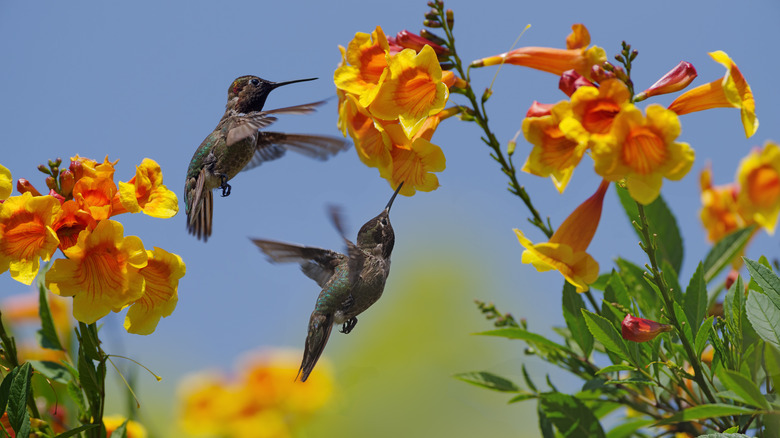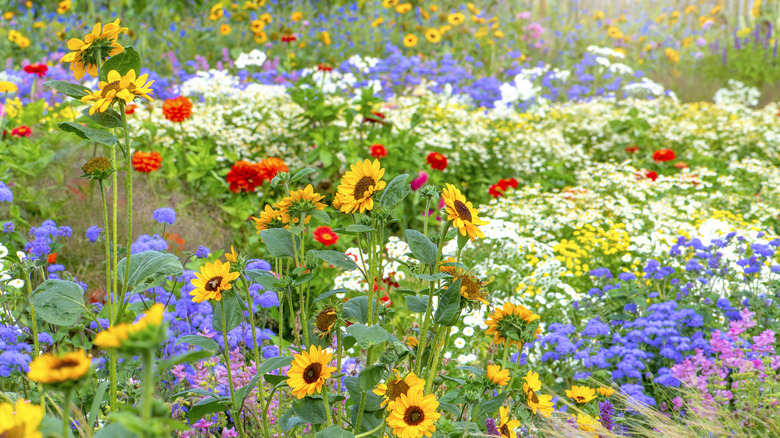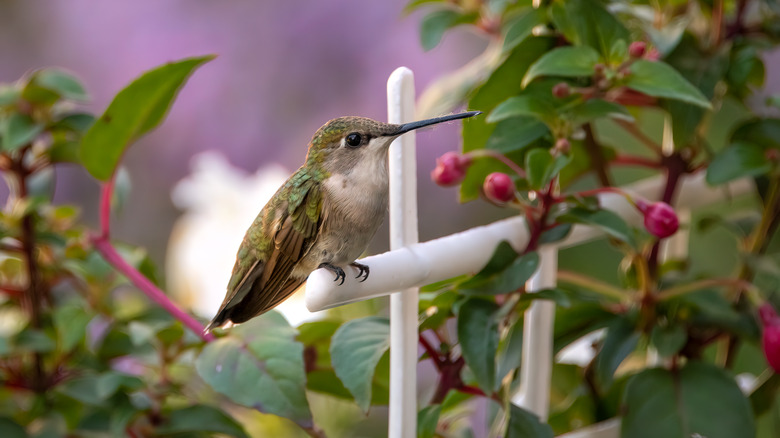Why Your Hummingbird-Friendly Flower Garden Isn't Working
If you live in the Americas, you're lucky to share your outdoor spaces with hummingbirds. These Lilliputian creatures are only located in the Western Hemisphere, and at the right times of the year, bird-lovers from Alaska to Argentina employ a whole range of different tactics to invite hummingbirds into their yards. Flower gardens are the most natural way to magnetize ruby-throats, rufouses, and broadtails to your yard, but even the most alluring-looking flowers may not be tempting enough to get the hummingbirds flocking over.
These members of the Trochlidae family have powerful eyesight that detects color much better than we do. And yet, despite the common belief that we should lure hummingbirds in with blossoms boasting fiery hues like red, yellow, and orange, it's actually the nectar content of the flowers that bring the birds back time and time again. Other factors like the location of your garden and whether you've included other bird-pleasing elements nearby could be keeping them away as well.
First and foremost, take the time to set your garden up in a place where they'll feel safe feeding. Combine that with a few feeders and a water source, and you've primed your outdoors environment for optimal hummingbird activity. Once you figure out how to attract hummingbirds to your garden, you can enjoy their visits for years to come.
Fill your garden with nectar-rich blossoms to attract hummingbirds
The biggest draw for these beautiful flying friends are, of course, the flowers themselves. Hummingbirds want blossoms that will guarantee them a good meal, and the most succulent flowers will up your chances of creating frequent feeding stops. Since most of us aren't botanists, we have to stick with tried-and-true flower varieties that we know hummingbirds adore. They may be drawn mostly to nectar content over color, but these birds know that bright colors and tubular shaped blooms will provide them with a nutritious meal.
Hummingbirds go crazy for blossoms in bright hues with shapes that make them want to stick in their pointy beaks for a long drink. Tuck some new types of flowers into your beds, and your yard could become a top hangout for them in no time at all. There are tons of flowers that hummingbirds absolutely love. The Missouri Prairie Foundation assembled a list of blooms that dole out copious amounts of nectar including columbines, bee balm, penstemons, phlox, and milkweed. Primroses, coreopsis, and coneflowers are all reliable additions too.
Is your garden's location and its contents calling to hummingbirds?
If you're still wondering why hummingbirds are steering clear of your yard, start with your garden's location. Hummingbirds naturally gravitate toward habitats that are open enough for them to survey their surroundings for danger as they eat. Thick bushes, shrubs, and tree branches are lovely for us to look at, but for hummingbirds, they're hiding places for potential predators. If your flower beds are fringed with foliage, trimming a few wayward branches may calm prospective visitors by giving them a clearer view of any possible danger.
Does your spot offer perching possibilities that aren't too shady? If your garden is branch-free, feathered friends may be more apt to frequent your yard if you give them somewhere to perch. Etsy has a selection of cute hummingbird perches that you can hang from the soffit of your roof or from a standing hook like this one from Duncraft.
While the flowers themselves are what we want calling to the birds, adding a few other lures can't hurt. A few extra feeders near the blooms give the hummingbirds a wider variety of food sources. Hummingbirds also love to bathe, so a bird bath, fountain, or even just a misting feature among your blossoms is hard for these visitors to resist.


